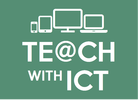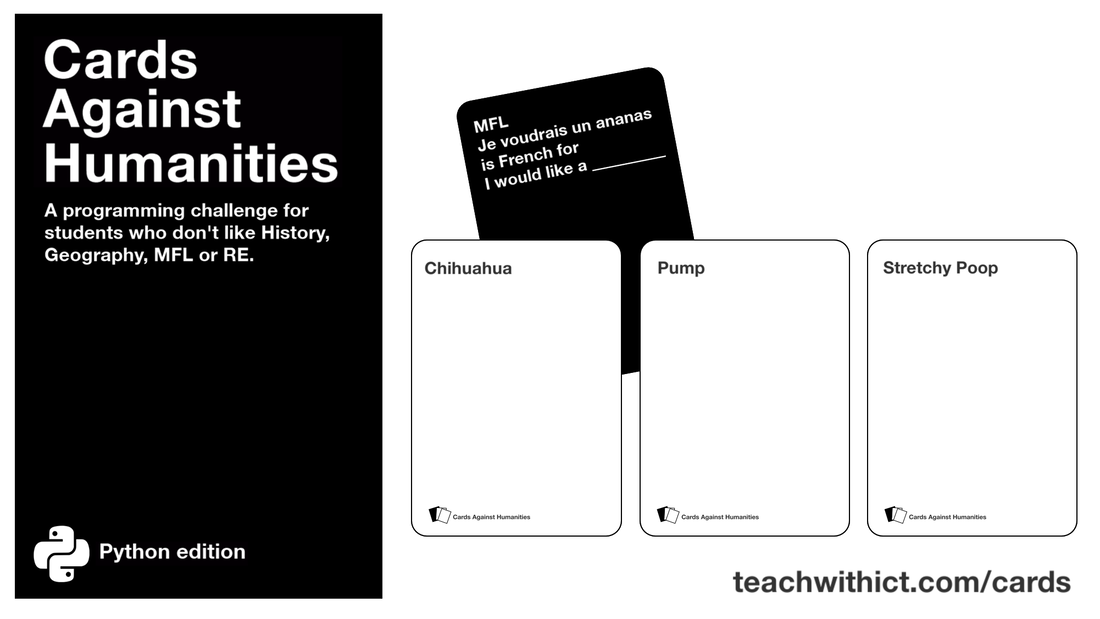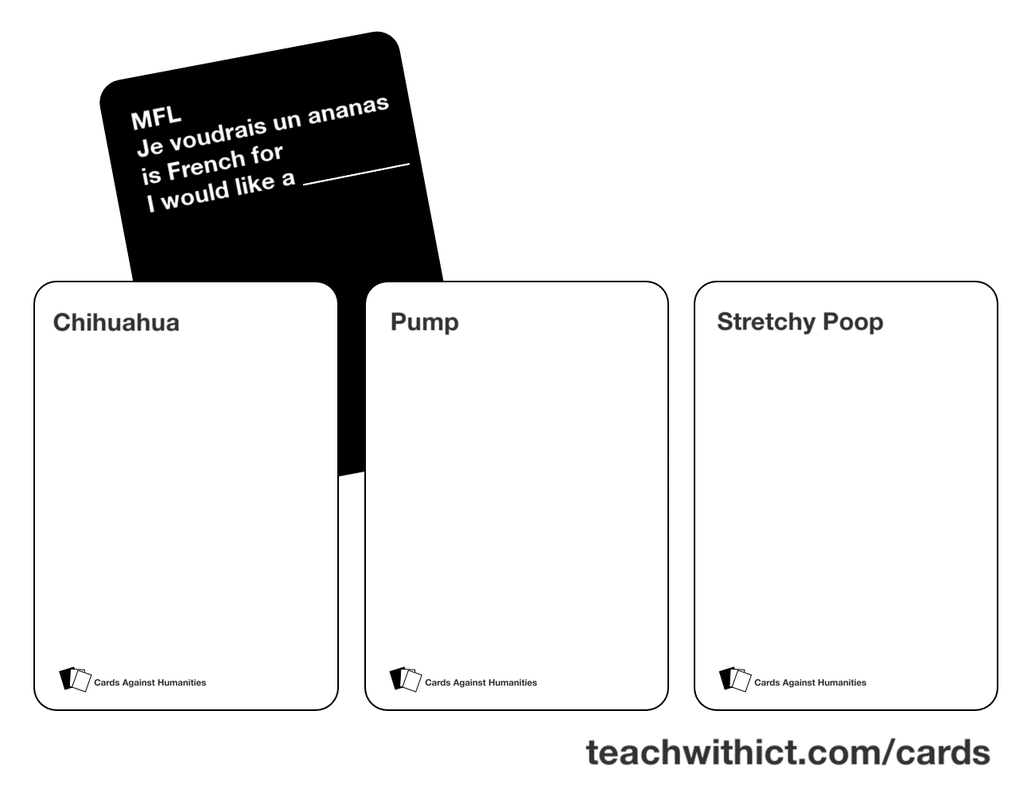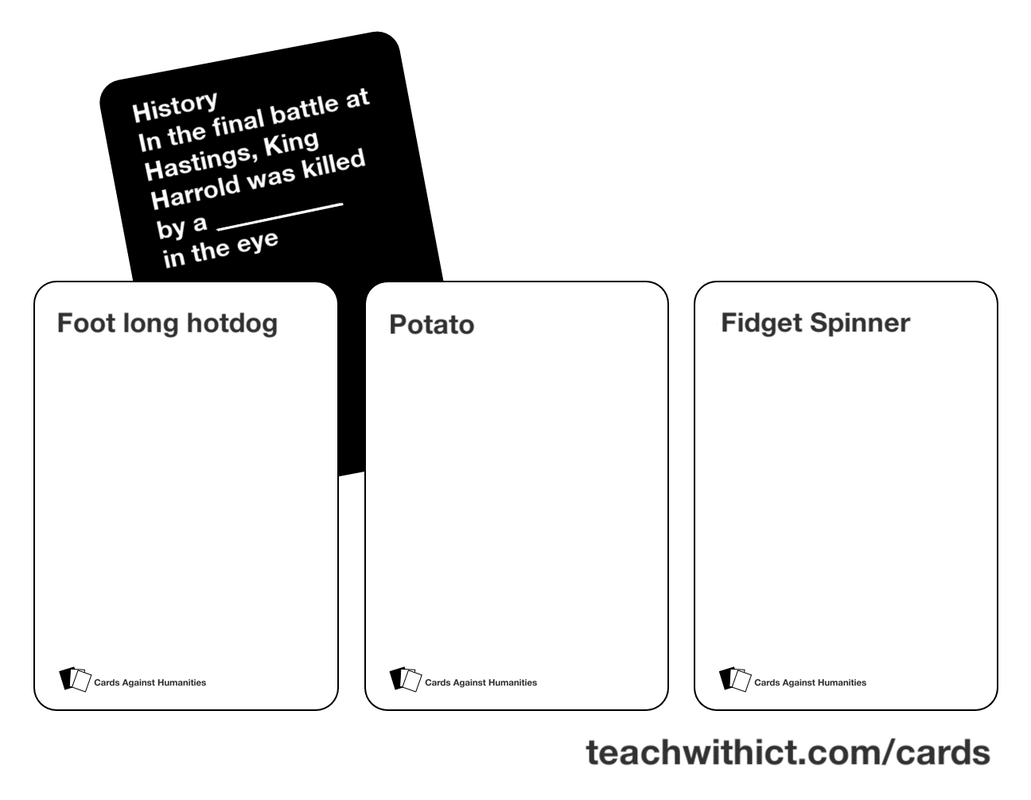Cards Against Humanities
Cards Against Humanities tutorial
Learning Objectives:
- Understand and use sequence in an algorithm
- Understand and use iteration in an algorithm (FOR and WHILE loops)
- Understand and use selection in an algorithm (IF, Else and Else if)
- Understand and use data structures in an algorithm (for example, Lists, Tables or Arrays)
Curriculum Mapping:
KS2:
- Design, write and debug programs that accomplish specific goals; solve problems by breaking them into smaller parts. Select, use and combine a variety of software on a range of digital devices to design and create a range of programs.
- Use sequence, selection and repetition in programs; work with variables and various forms of input and output
- Use logical reasoning to explain how some simple algorithms work; detect and correct errors in algorithms and programs
KS3:
- Use two or more programming languages, at least one of which is textual, to solve a variety of computational problems.
STUDENT: COMPUTATIONAL THINKER:
- 5a: Students break problems into component parts, extract key information, and develop descriptive models to understand complex systems or facilitate problem-solving.
- 5c: Students break problems into component parts, extract key information, and develop descriptive models to understand complex systems or facilitate problem-solving.
- 5d: Students understand how automation works and use algorithmic thinking to develop a sequence of steps to create and test automated solutions.
EDUCATOR: COMPUTATIONAL THINKING COMPETENCIES:
- 4b: Design authentic learning activities that ask students to leverage a design process to solve problems with awareness of technical and human constraints and defend their design choices.
COMPUTER SCIENCE EDUCATORS:
- 2a: Plan and teach computer science lessons/units using effective and engaging practices and methodologies:
i. Select a variety of real-world computing problems and project-based methodologies that support active and authentic learning and provide opportunities for creative and innovative thinking and problem solving
ii. Demonstrate the use of a variety of collaborative groupings in lesson plans/units and assessments
iii. Design activities that require students to effectively describe computing artifacts and communicate results using multiple forms of media
iv. Develop lessons and methods that engage and empower learners from diverse cultural and linguistic backgrounds
v. Identify problematic concepts and constructs in computer science and appropriate strategies to address them
vi. Design and implement developmentally appropriate learning opportunities supporting the diverse needs of all learners
vii. Create and implement multiple forms of assessment and use resulting data to capture student learning, provide remediation and shape classroom instruction
CSTA K–12 CS Standards:
- 1B-AP-08: Compare and refine multiple algorithms for the same task and determine which is the most appropriate.
- 1B-AP-09: Create programs that use variables to store and modify data.
- 1B-AP-10: Create programs that include sequences, events, loops, and conditionals.
- 1B-AP-11: Decompose (break down) problems into smaller, manageable subproblems to facilitate the program development process.
- 1B-AP-13: Use an iterative process to plan the development of a program by including others' perspectives and considering user preferences.
- 1B-AP-15: Test and debug (identify and fix errors) a program or algorithm to ensure it runs as intended.
- 1B-AP-17: Describe choices made during program development using code comments, presentations, and demonstrations.
- 2-AP-11: Create clearly named variables that represent different data types and perform operations on their values
- 2-AP-12: Design and iteratively develop programs that combine control structures, including nested loops and compound conditionals.
- 2-AP-15: Seek and incorporate feedback from team members and users to refine a solution that meets user needs.
- 2-AP-16: Incorporate existing code, media, and libraries into original programs, and give attribution.
- 2-AP-17: Systematically test and refine programs using a range of test cases.
- 3A-AP-14: Use lists to simplify solutions, generalizing computational problems instead of repeatedly using simple variables.
- 3A-AP-15: Justify the selection of specific control structures when tradeoffs involve implementation, readability, and program performance, and explain the benefits and drawbacks of choices made.
AREA OF LEARNING AND EXPERIENCE: Science and Technology:
Computation is the foundation for our digital world.
Progression step 3
- I can use conditional statements to add control and decision-making to algorithms.
- I can identify repeating patterns and use loops to make my algorithms more concise.
- I can explain and debug algorithms.
Progression step 4
- I can decompose given problems and select appropriate constructs to express solutions in a variety of environments.
- I can select and use data structures that efficiently manage data in algorithms.
- I can plan and implement test strategies to identify errors in programs.
Progression step 5
- I can identify, define and decompose problems, choose appropriate constructs and express solutions in a variety of environments.
- I can use file-handling techniques to manipulate data in algorithms.
- I can test, evaluate and improve a solution in software.
Cards Against Humanities is a phrasal template word game, where one player prompts other players for a list of words to substitute blanks in a question or phrase before reading out the completed phrase or question aloud.
Example:
We start with a question or phrase containing one or more blanked out words. Here’s a basic example:
Rumble in the _______.
We then prompt the user to fill in the gaps, in this case, with a noun or place. We might end up with something like this:
Rumble in the Toilet.
In this lesson, students will learn how to code a “Cards Against Humanities” game in Python. The game will work by prompting the user to enter some words (e.g. person’s name, noun, adjective, place, object etc.) and substitute these with blanks in a quote from History, phrase in French or Spanish, or Geography question etc.
Examples
There are several ways to create a Cards Against Humanities game in Python. In our version, the program will pick a phrase or question at random from a list of humanities subjects (History, Geography, Modern Foreign Languages or Religious Studies). However, before the students start coding their “Ultimate Cards Against Humanities” game, start them off with a simplified with a simple version:
Step 1. Creating your first Cards Against Humanities game
Start by sharing the following code snippet. Challenge the students to predict what will happen before revealing the answer.
|
noun = input("Enter a noun: ")
print("Rumble in the " + noun) |
- Have the students copy the code then modify it so that the game requires 2 or more user inputs (i.e. a phrase or questions that contains 2 or more blanks).
Example:
|
verb = input("Enter a verb: ")
verb2 = input("Enter another verb: ") plural = input("Enter a plural noun e.g. Cats or Dogs: ") print("That's one small " + verb + " for man, one giant " + verb2 + " for " + plural.") |
In the next version, the students will create a text file containing several questions or phrases (containing blanks). Just like the previous example, the program will ask the user to enter one or several nouns, verbs, adjectives etc. but this time will pick a question or phrase at random from a text file.
Step 1. Introducing the ‘String replace method’
Before creating their text file, have the students first explore the ‘string replace method’.
Explain to the students that sometimes, in Python, you find yourself in a situation where you want to modify the contents of string by replacing one piece of text with another. Luckily, Python makes this job easy thanks to the string replace method.
1. To help them understand how the .replace() method works, share the following code with the students.
Tip: As before, challenge the students to predict what the code will do before revealing the answer.
|
string = "This is a string"
string = string.replace("is", "was") print(string) |
- Have the students copy the code then modify it by changing the string or changing the replacement text.
Explanation
Explain that, in the above example, the line ‘string = string.replace(“is”, “was”) looks for the word “is” in the sentence and replaces it with the word “was”. Inform the students that they will be using the .replace() method to replace the blank(s) in their Cards Against Humanities game with the word(s) input by the user.
Step 2. Creating the text file
Next, the students need to create a text file for their Cards Against Humanities game, for the purpose of this example, we will call the file 'cards.txt'.
Challenge 3:
- Challenge the students to create a list of historical quotes, geography questions or phrases in French/Spanish etc. and store each one on a different line – They should type in the word ‘blank’ for the word they want to be replaced, for example:
|
MFL: Je voudrais un ananas is French for I would like a blank
History: In the final battle at Hastings, King Harold was killed by a blank in the eye Geography: Plucking is a process of erosion that occurs during blank |
1. Share the following worked example with the students:
|
# Program to read a random question or phrase from a file and print the game card with the user's response
import random # Open the Cards Against text file f = open('cards.txt','r') # Read the whole file and store each line in a list cardText = f.readlines() # Choose a random line from the list card = random.choice(cardText) # Ask the user to input a noun noun = input("Enter a noun: ") # Replace the blank with the user's input card = card.replace("blank", noun) # Print out the game card including the user's response print(card) |
- Have the students copy the code then modify it so that it displays the randomly chosen card before prompting the user for their response.
Resources:
|
Cards Against Humanities Solution
|
| ||
Taking it further
|
Solution (Advanced)
|
| ||
Python web, python programming language, python programming, python coding.




